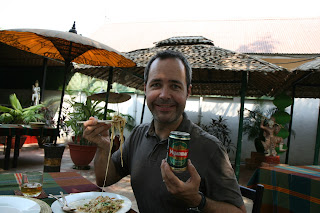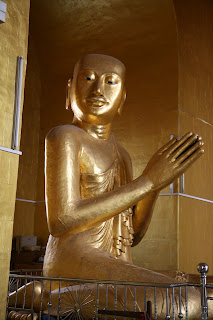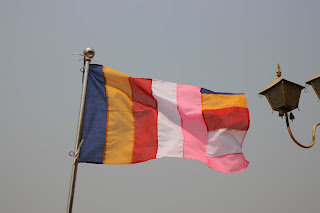 |
| To quote Bart Simpson: "Free and easy, Lis'! There's nothing like an unfurnished basement for pure comfort." |
Yep, Yangon is hot and humid. And if it gets so hot that you need a refreshing drink that eats like a meal, a strawberry lassi at one of the many south Asian joints in town is just the ticket.
Of course, stay on your guard, as the sidewalk might swallow you at any moment - particularly at night with the poor-to-nonexistent street lighting.
If you're not sweating enough already, you can always park it at an authentic Burmese tea house for bottomless & free jasmine tea served in the same cup as the last person at your table, and order a variety of other hot and cold drinks and snacks at reasonable prices.
But eventually one has to abandon these Yagonian delights and move on - in our case, we were catching the overnight train to Mandalay.
Popular spot, the train station. We couldn't wait to check out our upper class 4-person sleeper cabin.
Well, it wasn't a Thai train, but we did share with a very nice young Irish couple, and there was room enough to lie down, though everything was coated in a thick layer of train soot and dust. And we only got a single small sheet for the bed, but that seemed OK given the high heat and lack of air conditioning. Adventure ho!
We crawled slowly out of Yangon, then gathered a very small amount of speed once we were on the open tracks.
People waiting on train platforms seemed uniformly curious about our express train as it cruised by at very non-express speeds.
Real estate is clearly cheap near the tracks, but it's amazing what some people can do with the space. A surprising number of people had flat-screen TVs in their nearly-open-air woven-bamboo homes.
We were nearing the peak of hot season, so most of the landscape was scorched and dry with not much to see besides an occasional ox cart. But sometimes if there was some water available you'd see a paddy trying to squeeze out an extra rice crop before the rainy season hit and growing would start in earnest.
We had a nice view of a typically smokey/smoggy sunset over the dry fields. We all ordered dinner to our car, confirming our orders with two different waiters. One brought our beer and then the tasty noodles at the appointed time, and life seemed good. After we were finished and the plates were cleared, the other waiter burst into our compartment and slammed an identical order down before we could react. I was the only one left in the car to attempt to communicate that we had already eaten and that they had doubled the order (which I'm pretty sure he already knew), and the waiter used a combination or irate yelling and stony stink-eye silence to force me into accepting the additional meals, which I did not. It's a bit strange that there was apparently competition between waiters for our orders, when the food all came from the only kitchen on the train and they were all railway employees...
As the sky darkened, we watched the blackened landscape float past, regularly punctuated by huge, golden, lit-up stupas (Buddhist towers). Now THIS was Burma.
However, the track was not getting any straighter or smoother, and we were being thrown around pretty handily on our bench seats. You could only read if you kept both your head and your book detached from any part of the train, or the jouncing made it impossible. Oh well, maybe it would feel like a massage later, or a cradle rocking us to sleep in the heat.
Um, no. In fact, the temperature dropped rather sharply later that night, and I felt very cold even wearing my sweater and with my towel and longyi draped over me as blankets. The train bucked like a bronco all night long - I can't believe we didn't derail at some points. You'd shimmy side to side, then front to back, and then the train would hit evenly-spaced hillocks that would literally cause your whole body to be airborne once per second or more often! I was on the top bunk, and during the big bumps could see the dark shape of the Irish girl across from me launch upwards the better part of a foot and block out the white wall behind her, over and over again. I have been sleeping in bunks my whole life, and am very confident on top, but a couple of times I had to reach out a hand and grab the safety rail because I was getting enough air that there was danger of being launched over the rail and onto the floor six feet below. At any rate, it was an experience, though not one we were immediately eager to repeat after 16 hours of non-stop bouncing.
The next morning we made our way groggily to our guest house in Mandalay, which was lovely. A huge, newly-built room, an older but very sharp and helpful female owner, and nice garden area.
We hid from heat of the day having noodles (well, Chad had noodles - Sarah cowered before the peanuty onslaught of Burmese food, as usual) and sampling the national Myanmar beer (yep, tastes like nothing, as usual).
The center of Mandalay is occupied by the old city, which is a huge square a couple of kilometres on each side, with a wide moat protecting the high city walls which are punctuated by temple-like guard towers every couple of hundred metres. The old city houses a royal palace, but it burned down and was rebuilt in the 1990s (i.e. it's not original). The rest of the old city is now military reservation which is off-limits to tourists, so there's not much point going inside.
At the northeast corner of the old city is Mandalay Hill (the hill in the above photo), which you can climb barefoot by a series of covered staircases leading through various temples on the way up.
You might think this lone monk is lonely. But he's smoking, chewing betel nut, talking on his cell phone, and weaving drunkenly down the sidewalk. Probably having a great time, but Buddha probably isn't too impressed.
Ah yes, betel nuts. Most men in Burma chew betel nut - sold in street stands everywhere, it's wrapped in a small leaf with some white paste and flavoured powders, then chewed not unlike chewing tobacco and gum. It apparently gives you a bit of a buzz, but it also ruins your teeth and turns your saliva brilliant, blood red - it makes your mouth look like it's bleeding. Chewers regularly spit on the sidewalk (see above photo). Watch where you step!
Just some green mangoes in our guest house garden.
The popular "cool" vehicle in Burma is a Jeep Wrangler that has been lowered and pimped out a bit with fancy wheels and other bling-bling. The above example is pretty tame.
But here's a fancier one at the head of a wedding convoy! Sweet.
That's either the bride or the mother of the bride under the umbrella, surrounded by bridesmaids.
And the rear is brought up by a big truck full of men and wedding supplies, including huge speakers blaring Burmese wedding music.
We decided to walk to Mandalay Hill and then climb up to the summit one morning before it got too hot. Across from the foot of the hill is a golden stupa surrounded by a grid of dozens upon dozens of huge white stupas. Burma is temple grand central - it makes Thailand look pretty weak in the temple department.
Lots off mirror and glass mosaics and murals on the walk up. The lower temples on Mandalay Hill are the destination for many wedding convoys.
As mentioned previously, all of southeast Asia is incredibly smokey/smoggy. The best visibility yet encountered was in Bangkok, which leads me to believe most of the bad brown haze is from smoke (as well as industrial air pollution). People burn rice paddies between harvests, they burn forests to clear land, they burn garbage rather than bury it, and they often cook food over wood fires. The result, beyond environmental harm, is a thick haze that limits your visibility to a few kilometres at best. Burma was definitely no exception. Things might be better in the rainy season when the rains wash some of the haze out of the atmosphere.
The dragonscale staircase roof winding up to one of the mid-hill temples.
Looking southward, at the northeast corner of the old city and moat. The far end of the moat is lost in the haze.
99% of dogs in Burma look like they were descended from the same mother, some kind of mid-sized short-haired terrier. This temple resident was particularly "awww"-worthy.
Looking back down the staircase. The forest of huge white stupas is visible behind it.
All Buddhist temples have bells and gongs that are rung for official purposes, but which anyone can ring anytime they feel like it. Even dorky tourists like us!
Bamboo loungers with headrests are all the rage in Burma. We saw people making these at the side of the road - few fasteners and tools are needed.
A rather large and authoritative Buddha tells you where to go.
Don't look at me man, I'm just praying over here.
A scary chinthe (guardian) with an aromatic garland.
Buddhist prayer flag.
Archways with (relatively modern) dated quotations.
After all those stairs, a cool snack in the shade was just the ticket. Walking up was a great decision - it wasn't that far, and it was peaceful and quiet the whole way because most of the tourists and pilgrims huddle around the base of the hill, or drive to the top and huddle around the peak.
Head-carrying is common in Burma; many people have excellent scalp-balancing skills.
Burmese rickshaw. It's a regular bike with a sidecar. The sidecar has one seat facing forwards, and another backwards. Talk about earning your keep: straining to move two fatty tourists at once while non-pollution-controlled trucks swarm around you on a 40 C street. Whew! (For some reason Yangon has outlawed scooters and motorcycles - which seems almost unthinkable in southeast Asia - so all you see are four-wheeled vehicles and these rickshaws.)
Next we skipped Mandalay's famous teak bridge, and opted for the nearer and quieter teak monastery. (Burma has the biggest reserves of teak in the world. At least for now - later on we saw barge after barge of huge raw logs being floated down the Irriwaddy, no doubt destined for China or Thailand.) Inside the entrance is an actual open well that contains water and is still used - a first for me.
Wow, that's much more elaborate than we expected! The temple is all teak, all carved, and supported on huge teak log pillars.
Of course the few chairs in evidence are also teak. True to form, the cat is not impressed.
The carving continues inside.
Next up was a demo of gold leaf making. Many stupas and Buddha statues in Burma are coated in gold leaf (like the massive Shwedagon Paya in Yangon). It's considered good luck to buy golf leaf and apply it to certain Buddha statues. Sheets of gold leaf are sold for such purposes. Gold is very malleable and can be made into almost unbelievably thin sheets, meaning that leaf is very inexpensive because it contains very little gold. Several shops in Yangon make gold leaf the traditional way, by hand.
You start with two ounces of 24 carat gold, and divide it into a few pieces. You flatten those pieces slightly, then break them into more pieces. Then you put each piece on its own sheet of (very strong) bamboo paper, forming a stack. You hammer the stack for a bit, flattening the gold inside, then take it out, slice up the gold, put each new piece on its own piece of paper, re-stack, then start hammering again. This time you hammer for almost an hour before deconstructing the stack, slicing up each piece of gold and re-stacking again. The final time, you have a stack of 1200 pieces of gold, each on its own piece of paper, and a team of 2 men beat it continuously for 5.5 hours with a sledge hammer. What you end up with is gold leaf, which is then cut into perfect squares by expert ladies and laid upon squares of paper for sale. The women above are unpacking/repacking the hammer-stacks of gold, and are cutting the finished leaf into squares.
 |
| A short stack of gold leaf for an intermediate stage of hammering |
 |
| Final stage of pounding: 5.5 hours. Damned straight they have their shirts off! |
 |
| A coconut shell with a hole in it slowly sinks into a bowl of water over 3.5 minutes, signalling when it's time for the pounders to turn the stack of paper and gold over |
Gold leaf is pretty amazing - it's relatively strong for its thickness, but the lightest breath of air can send it rolling along a table. The shop gave us each a beauty spot of gold leaf. I bought a small stack of tiny gold leaf squares as a souvenir for a couple of bucks . But upon later reflection I wasn't sure that was such a good idea, since the gold probably came from a Burmese mine, where working conditions are probably bad and maybe even forced. Lesson: you sure have to stay alert to travel ethically.
All-purpose wheel-driven rototiller-like farm engines have popped up all over the world on our travels. In Burma, it seems pretty common practice to tear off the front end of an ancient truck or farm tuk-tuk, and attach one of these things in place of the original engine and front wheels - usually via a wooden beam! Voila, your truck works again, albeit at low speeds.
And finally, as night falls, kids in Mandalay descend upon Happy Palace. Creepy and borderline disturbing-looking during the day, it is well-attended at night, complete with singing cartoon animal mascots and mini circus rides. Hey, if Disneyland is out of reach, you have to make your own!




















































No comments:
Post a Comment